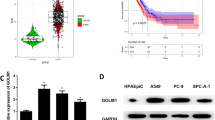Abstract
Accumulating investigations illustrated that miRNA acts as a key regulator in tumor progression, whereas regulatory role of miR-96-5p in lung adenocarcinoma (LUAD) is warranted. Thus, we sought to probe mechanism of miR-96-5p in this disease. Through bioinformatics analysis, miR-96-5p level in normal tissue and LUAD tissue in TCGA database were obtained. Meanwhile, mRNA expression dataset was analyzed to obtain downregulated mRNAs binding to miR-96-5p. qRT-PCR assessed miR-96-5p and ARHGAP6 mRNA in LUAD. Western blot assessed protein level of ARHGAP6 in LUAD. Dual-luciferase reporter gene detection verified targeting relationship of miR-96-5p and ARHGAP6. Biological functional experiments such as CCK-8, colony formation, scratch healing, and Transwell assessed cell proliferation, migration, and invasion. MiR-96-5p was overexpressed, which fostered LUAD cell proliferation, migration, and invasion. ARHGAP6 was downregulated in LUAD and targeted by miR-96-5p. ARHGAP6 upregulation prominently restored promotion of miR-96-5p on cell progression. MiR-96-5p could stimulate LUAD progression through targeting ARHGAP6. This study generates a novel direction and lays a theoretical basis for targeted therapy.




Similar content being viewed by others
Data availability
The data used to support the findings of this study are included within the article. The data and materials in the current study are available from the corresponding author on reasonable request.
References
Mostafa AA, Morris DG (2014) Immunotherapy for lung cancer: has it finally arrived? Front Oncol 4:288. https://doi.org/10.3389/fonc.2014.00288
Ferlay J et al (2019) Estimating the global cancer incidence and mortality in 2018: GLOBOCAN sources and methods. Int J Cancer 144:1941–1953. https://doi.org/10.1002/ijc.31937
Devarakonda S, Morgensztern D, Govindan R (2015) Genomic alterations in lung adenocarcinoma. Lancet Oncol 16:e342-351. https://doi.org/10.1016/S1470-2045(15)00077-7
Antonia SJ (2019) Durvalumab after chemoradiotherapy in stage III non-small-cell lung cancer Reply. N Engl J Med 380:990. https://doi.org/10.1056/NEJMc1900407
Kanodra NM, Silvestri GA, Tanner NT (2015) Screening and early detection efforts in lung cancer. Cancer 121:1347–1356. https://doi.org/10.1002/cncr.29222
Sanada, H. et al (2019) Involvement of dual strands of miR-143 (miR-143–5p and miR-143–3p) and their target oncogenes in the molecular pathogenesis of lung adenocarcinoma. Int J Mol Sci 20, https://doi.org/10.3390/ijms20184482
Greenawalt EJ et al (2019) Targeting of SGK1 by miR-576-3p inhibits lung adenocarcinoma migration and invasion. Mol Cancer Res 17:289–298. https://doi.org/10.1158/1541-7786.MCR-18-0364
Sun Y et al (2016) miR-297 acts as an oncogene by targeting GPC5 in lung adenocarcinoma. Cell Prolif 49:636–643. https://doi.org/10.1111/cpr.12288
Zhang H, Chen R, Shao J (2020) MicroRNA-96-5p facilitates the viability, migration, and invasion and suppresses the apoptosis of cervical cancer cells bynegatively modulating SFRP4. Technol Cancer Res Treat 19:1533033820934132. https://doi.org/10.1177/1533033820934132
Wang B, Liu X, Meng X (2020) miR-96-5p enhances cell proliferation and invasion via targeted regulation of ZDHHC5 in gastric cancer. Biosci Rep 40(4):BSR20191845
Ding L et al (2021) AIMP3 inhibits cell growth and metastasis of lung adenocarcinoma through activating a miR-96-5p-AIMP3-p53 axis. J Cell Mol Med 25:3019–3030. https://doi.org/10.1111/jcmm.16344
Tang H, Liu Y, Cheng W, He Z, Zhou N (2019) microRNA-96-5p induces the epithelial-mesenchymal transition to promote the metastasis of hepatocellular carcinoma by post-transcriptionally downregulating Talin 1. Int J Clin Exp Pathol 12:1897–1908
Zhou Y et al (2019) MicroRNA-195 suppresses the progression of lung adenocarcinoma by directly targeting apelin. Thorac Cancer 10:1419–1430. https://doi.org/10.1111/1759-7714.13087
Wang J et al (2020) miR-15b enhances the proliferation and migration of lung adenocarcinoma by targeting BCL2. Thorac Cancer 11:1396–1405. https://doi.org/10.1111/1759-7714.13382
Prakash SK et al (2000) Functional analysis of ARHGAP6, a novel GTPase-activating protein for RhoA. Hum Mol Genet 9:477–488. https://doi.org/10.1093/hmg/9.4.477
Wu Y, Xu M, He R, Xu K, Ma Y (2019) ARHGAP6 regulates the proliferation, migration and invasion of lung cancer cells. Oncol Rep 41:2281–2888. https://doi.org/10.3892/or.2019.7031
Chen WX et al (2019) Bioinformatics analysis of potential therapeutic targets among ARHGAP genes in breast cancer. Oncol Lett 18:6017–6025. https://doi.org/10.3892/ol.2019.10949
Li J, Liu Y, Yin Y (2016) Inhibitory effects of Arhgap6 on cervical carcinoma cells. Tumour Biol 37:1411–1425. https://doi.org/10.1007/s13277-015-4502-z
Li P, Lv H, Xu M, Zang B, Ma Y (2020) ARHGAP6 promotes apoptosis and inhibits glycolysis in lung adenocarcinoma through STAT3 signaling pathway. Cancer Manag Res 12:9665–9678. https://doi.org/10.2147/CMAR.S257759
Funding
1. This study was supported by the funds from 2020 Zhejiang Medical and Health Science and Technology Program (above item). Funds: 2020KY053.
2. This study was supported by the funds from Zhejiang Lung Cancer center.
Author information
Authors and Affiliations
Contributions
ZF contributed to the study design. BZ conducted the literature search. YC and SW acquired the data. CH wrote the article. FY performed data analysis. EL drafted. ZF and ZB revised the article and gave the final approval of the version to be submitted. All authors read and approved the final manuscript.
Corresponding author
Ethics declarations
Ethics approval and consent to participate
Not applicable.
Consent for publication
All authors consent to submit the manuscript for publication.
Conflict of interest
The authors declare no competing interests.
Additional information
Communicated by Michal Witt
Publisher's note
Springer Nature remains neutral with regard to jurisdictional claims in published maps and institutional affiliations.
Rights and permissions
About this article
Cite this article
Liu, Z., Cui, Y., Wang, S. et al. MiR-96-5p is an oncogene in lung adenocarcinoma and facilitates tumor progression through ARHGAP6 downregulation . J Appl Genetics 62, 631–638 (2021). https://doi.org/10.1007/s13353-021-00652-1
Received:
Revised:
Accepted:
Published:
Issue Date:
DOI: https://doi.org/10.1007/s13353-021-00652-1




